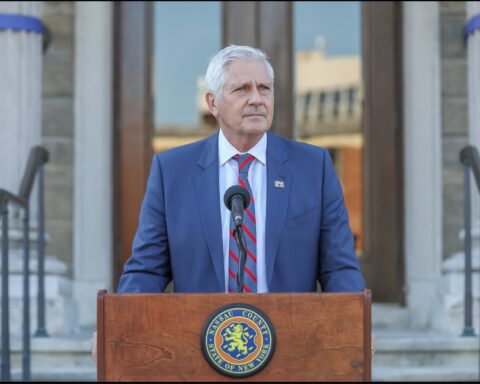A newly built bridge in China’s Sichuan province collapsed Tuesday, just months after it officially opened, raising fresh questions about the country’s rush to expand infrastructure amid concerns over safety standards and government oversight.
The Hongqi Bridge, a 758-meter structure designed to link China’s interior to Tibet, gave way after a series of heavy landslides struck the surrounding mountainside, local officials in Maerkang city told Reuters. Videos circulating on Chinese social media captured the dramatic moment the bridge crumbled, sending massive clouds of dust into the air before the roadway plunged hundreds of meters into the valley below.
Other footage showed large sections of the bridge missing, with only fragments of roadway suspended precariously over the river. Rescue and inspection crews were later seen cordoning off the site as authorities assessed the damage.
Local police had reportedly closed the bridge to traffic on Monday afternoon after identifying cracks on nearby slopes and shifts in the ground that signaled potential instability. Despite those warnings, by Tuesday afternoon the conditions worsened, triggering landslides that ultimately caused the collapse of the bridge’s approach and roadbed, according to a statement from the local government.
Authorities confirmed that no injuries or fatalities were reported.
The Hongqi Bridge had been hailed by Chinese officials as a symbol of progress and connectivity when it opened earlier this year. Promotional videos released by its builder, the state-owned Sichuan Road & Bridge Group, depicted the project as a triumph of modern engineering and a key link in Beijing’s efforts to integrate Tibet more closely into the national economy.
Now, that same project is under investigation. The Maerkang city government announced that a formal inquiry is underway to determine the cause of the failure, though early reports suggest the region’s unstable terrain and recent heavy rains may have played a role.
While Chinese officials framed the collapse as an unfortunate natural disaster, the incident has fueled skepticism among observers who see it as part of a wider pattern of overambitious construction projects that often prioritize speed and political optics over long-term reliability.
Infrastructure failures are not uncommon in China, where state-backed construction drives have delivered vast new roads, bridges, and high-speed rail networks — often completed on accelerated timelines. Yet critics argue that quality control and transparency have lagged behind, particularly in remote regions where oversight is limited and local officials face pressure to meet central government targets.
The Hongqi Bridge’s collapse underscores those concerns. What was once touted as a “major engineering milestone,” according to state media, now serves as a stark reminder of the risks tied to China’s infrastructure boom.
As Beijing continues to promote large-scale projects both domestically and abroad through its Belt and Road Initiative, the failure of a key bridge in its own interior raises questions about the sustainability — and safety — of the model it is exporting.
The investigation into the Hongqi Bridge’s collapse remains ongoing, but for many, the damage extends beyond the fallen concrete. It strikes at the heart of a system that rewards political achievement over public accountability — a system now visibly cracking under its own weight.
[READ MORE: Charles Payne Pushes Back on Trump’s 50-Year Mortgage Plan]












